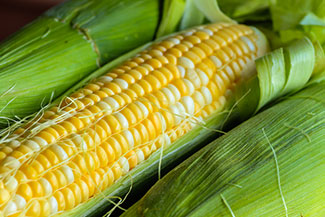Corn Tales

Get out the salt, pepper, and butter! Local sweet corn is available throughout much of Atlantic Canada now. Unlike its relative field corn, (grown for livestock feed or for cooking oil or ethanol), sweet corn, as the name suggests, is much higher in sugar than other varieties, making it a desirable food for our tables.
Corn is native to the western hemisphere, but its actual birthplace is uncertain. Many historians feel it was first cultivated as a food in Mexico, and spread in popularity when Columbus and his men learned about it and brought it back to Europe with them. In First Nations culture, corn is one of the “three sisters” of corn, beans and squash, which were grown together, both to benefit one another during the growing process and to provide a balanced diet to those who grew them.
Sweet corn comes in three colours: yellow, white, and bicolour yellow-and-white mixed. The bicolour is often incorrectly referred to as “Peaches and Cream” corn. That name belongs to a specific, older variety of bicolour corn which is actually not often grown today—there are many other varieties that are sweeter, earlier to ripe, but many people still use that term much as we use the term Kleenex, a brand name, to describe any paper tissue product we use in place of handkerchiefs.
When selecting sweet corn for purchase, buy it still in the husks if at all possible. The husks covering the cob should be a healthy green, and the corn-silk tassels that come out of the cob should also be pale green, not brown or black. Peel back the tip of the cob and check the kernels to make sure they are pearly, plump and full, not shrunken or discoloured. You can keep fresh corn in your fridge for a couple of days but after that, the sweetness will be reduced: it’s best picked and eaten the same day. Local farmers markets can tell you when their corn was harvested, and it’s usually that morning, so you know you’re getting fresh, sweet corn.
You can cook corn in a number of ways.
- For a good old-fashioned corn boil, remove the husks and silk and drop cobs into boiling water for 5-8 minutes.
- To barbecue, carefully peel the husks away from the cob but leave them still attached at the base of the cob. Remove the silks, then brush corn with olive oil, add seasonings such as salt and pepper), then wrap the husk back around the cob. Place wrapped cobs on a hot barbecue grill for 15 minutes, turning every couple of minutes.
- In a hurry? Leave husks and silks on the corn, but cut off the end of the cob where the husks join the stem. Put cobs on a plate and microwave 4-6 minutes per cob. Let stand for a couple of minutes, then peel the husks back from the end that you cut off. This will remove husks AND silks all at once with minimal mess. If you’ve already husked the corn, place it on a plate, wrapped in damp paper toweling, and microwave as above.